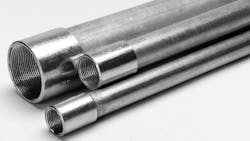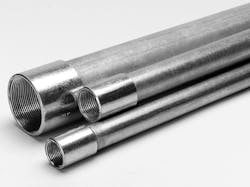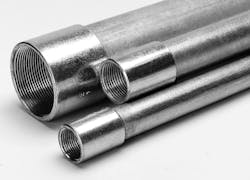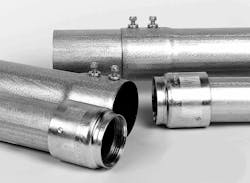Steel conduit has been in use as a “raceway system” for electrical conductors since the early 1900s. The wall thickness and strength of steel make metal conduit the wiring method recognized as providing the most mechanical protection to the enclosed conductors. An additional benefit of using steel conduit is that the NEC recognizes a properly installed metal conduit system as an equipment grounding conductor.
Three basic types of steel conduit are in use today: rigid metal conduit, intermediate metal conduit, and electrical metallic tubing. Let's take a closer look at the features of each type.
Rigid metal conduit — RMC (ferrous metal). RMC is a listed threaded metal raceway of circular cross section with a coupling, which can be either a standard straight tapped conduit coupling or the integral type (Photo 1). Threads on the uncoupled end are covered by industry color-coded thread protectors, which protect the threads, keep them clean and sharp, and aid in trade size recognition. RMC is available in trade sizes ½ through 6. (See the Table for metric trade size designators.) Thread protectors for trade sizes 1, 2, 3, 4, 5, and 6 are color-coded blue; trade sizes ½, 1½, 2½, and 3½ are black; and trade sizes ¾ and 1¼ are red. The standard finished length of RMC with coupling is 10 feet.
RMC can have a primary coating of zinc, a combination of zinc and organic coatings, or a nonmetallic coating, such as PVC. Supplementary coatings can be applied to all three where additional corrosion protection is needed.
RMC is the heaviest-weight and thickest-wall steel conduit. Where galvanized by the hot-dip process, it has a coating of zinc on both the inside and outside. Electro-galvanized RMC has a coating of zinc on the exterior only, with approved corrosion resistant organic coatings on the interior. RMC with alternate corrosion protection generally has organic coatings on both the exterior and the interior surfaces. Galvanized RMC is noncombustible and can be used indoors, outdoors, underground, concealed or exposed. RMC with non-zinc-based coatings may have temperature limitations that will be noted on the manufacturer's product label and may not be listed for use in environmental air spaces; consult the manufacturer's listings and markings.
Intermediate Metal Conduit — IMC (ferrous metal). Developed in the '70s, IMC is a listed threaded steel raceway of circular cross section with a coupling that can be either a standard straight-tapped conduit coupling or the integral type (Photo 2). Just as with RMC, industry color-coded thread protectors protect the uncoupled ends of the conduit and keep them clean and sharp, and aid in trade size recognition. IMC is available in trade sizes ½ through 4. Thread protectors for trade sizes 1, 2, 3 and 4 are color-coded orange; trade sizes ½, 1½, 2½, and 3½ are yellow; and trade sizes ¾ and 1¼ are green. The standard finished length of IMC, with coupling, is 10 feet.
IMC has a thinner wall than RMC and weighs about one-third less than RMC. The outside has a zinc-based coating, and the inside has an approved organic corrosion-resistant coating. IMC is interchangeable with galvanized RMC. Both have threads with a 0.75-inch-per-foot taper, use the same couplings and fittings, have the same support requirements, and are permitted in the same locations.
Electrical Metallic Tubing — EMT (ferrous metal). Also commonly called thin-wall, EMT is a listed steel raceway of circular cross section, which is unthreaded and normally 10 feet long (Photo 3). The outside corrosion protection is zinc-based, and the inside features an approved corrosion-resistant organic coating. EMT with integral couplings is available in trade sizes 2½ through 4.
EMT is installed by use of setscrew, identation or compression-type couplings and connectors. It can have an integral coupling that comprises an expanded, “bell” shaped tube on one end with setscrews (Photo 4).
In addition to standard RMC, IMC, and EMT, PVC-coated steel conduit (PVC) is also available in one of three types. Couplings are supplied separately.
-
Primary PVC coating over bare steel, which is a listed rigid conduit for environmentally suitable locations.
-
A PVC coating over listed galvanized steel conduit. This is a supplementary coating intended for added protection in severely corrosive locations.
-
A primary PVC coating over a supplementary coating of zinc. This is also intended for severely corrosive locations.
These PVC-coated raceways are generally installed as a system, which means the fittings, conduit bodies, straps, hangers, boxes, etc., are also coated. Installations do exist, however, where only a coated elbow is used in a galvanized conduit run, such as where emerging from the soil or concrete. Manufacturers' instructions are very important when installing PVC-coated products and systems, and special tools are generally required for installation.
Applications. There are two primary reasons to use steel conduit. It's the best possible protection of your electrical conductor and wiring systems, and it facilitates the insertion and extraction for conductors and wiring. Today, steel conduit is used in virtually every application where electrical conduit and wiring is present: commercial, retail and residential buildings, manufacturing and other industrial facilities, health-care, educational and other institutions, and a wide variety of indoor, outdoor, and underground applications, even where corrosive and hazardous conditions exist.
In some cases, different types of steel conduit are best for specific applications. For example:
-
RMC has the thickest wall, which makes it the heaviest steel conduit. It can be used indoors, outdoors, underground, and in both concealed and exposed applications.
-
IMC has a thinner wall and weighs less than RMC. IMC can be used for the same applications as galvanized RMC.
-
EMT is the lightest-weight steel conduit manufactured. Field workers typically find it easy to alter, reuse, or redirect EMT. Even though EMT is made of lighter-walled steel, it still provides substantial physical protection and can be used in most exposed locations, except where severe physical damage is a possibility.
-
PVC coatings may be used over bare or galvanized steel conduit or conduit that has a supplementary zinc coating. PVC coatings used over galvanized steel conduit, or over steel conduit, which has a supplementary coating of zinc, may also be used in severely corrosive locations and atmospheres.
Manufactured elbows, nipples, and couplings. As strong as all of those 10-foot sections of steel conduit are, they still don't make a complete system without the aid of elbows, nipples, and couplings.
Factory elbows. Elbows of the correct type and dimensions are an important element of any raceway installation. They're bent sections of conduit or tubing used to change raceway direction or bypass obstructions. IMC and RMC elbows are threaded on both ends.
Factory-made elbows in both standard and special radius are readily available for all sizes of RMC, IMC, and EMT. Elbows with integral couplings are available in trade sizes 2½ through 4. Specialized large radius elbows, which are often referred to as “sweeps,” are also available. They are typically custom-ordered to solve various installation problems. Sweeps are typically used to facilitate easier wire pulls, assist with conduit installs in limited or geometrically difficult spaces, provide specific stub-up length, or enhance protection of communications or fiber optic cables during wire pulls.
Physical dimensions of factory-made elbows for RMC, IMC, and EMT vary between manufacturers. When installing factory elbows for a job, be aware of this variability to avoid installation problems. Always measure to be safe. To order factory elbows you need to specify the raceway type, trade size, and angle of bend. If ordering a special radius elbow, you'll also have to specify the radius.
Nipples. A nipple is a short length of conduit or tubing material that's used to extend a conduit system. Nipples are used between conduit or tubing and items such as, but not limited to, fittings, boxes, and enclosures or between two boxes, two enclosures, etc. When nipples are used to extend a conduit run to an enclosure, box, etc., the percentage wire fill requirements shown in Chapter 9, Table 1 of the NEC apply.
When a nipple is installed between boxes, enclosures, etc. and it doesn't exceed 24 inches, wire fill is permitted to be 60%. Factory-made RMC nipples are threaded on both ends and are available in all sizes in lengths up to and including 12 inches. Longer lengths are available by special order or may be field-fabricated.
Couplings. Factory-made couplings for EMT, IMC, and RMC are available in all conduit sizes. Integral couplings are available on trade sizes ½ through 4. On EMT, the coupling is a belled end of the conduit with specific setscrews. For IMC and RMC, the coupling is a separate component that permits joint make-up by turning the outside coupling rather than the conduit.
Editor's note: The information presented in this article was adapted from source material provided by the Steel Tube Institute of North America (www.steelconduit.org).




